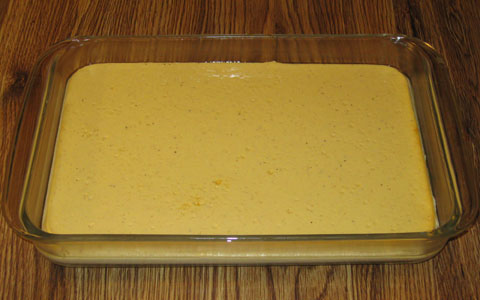|
|
 |
Baked Eggnog Cheesecake—Prototype 23:
2-to-1 Blend of Yogurt Cheese and Cottage Cheese (1CT-2YG [1 part cottage
cheese, 2 parts yogurt cheese]):
Prepare ahead of time 16 ounces of yogurt cheese, derived from one 32-ounce
container of nonfat yogurt. If the resulting yogurt cheese falls below 16
ounces, add back enough of the whey (that was strained out from the yogurt) to
make up the difference. To this yogurt cheese combine 8 ounces (1 cup) of
whipped, lowfat cottage cheese.
Batter:
24 oz. (about 3 cups) 2-to-1 blend of yogurt cheese and cottage cheese (see
above)
3/4 cup granulated sugar
1 teaspoon vanilla extract
1 teaspoon rum extract
1/2 teaspoon nutmeg
2 1/3 cups light eggnog
1 tablespoon xanthan gum
3 eggs
Place into greased 13" x 9" glass ("Pyrex") pan, and bake
in tub at 300 degrees for 80-90 minutes. Shut off oven afterwards, leaving door
slightly ajar, for 60 minutes. Next, remove pan containing cheesecake from tub
and oven, and let cool at room temperature for 90-120 minutes, then (with
cheesecake still in pan) refrigerate.

|
|

|

